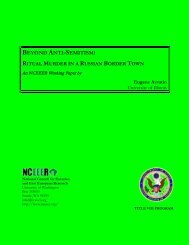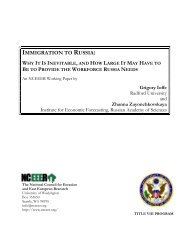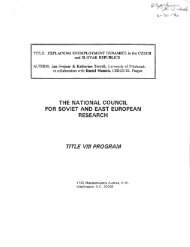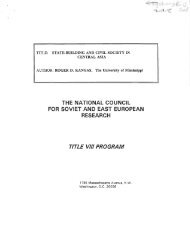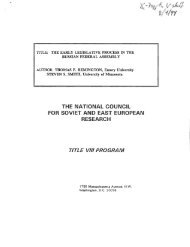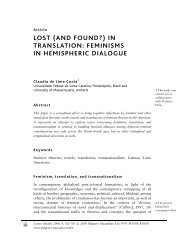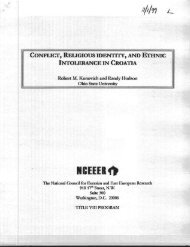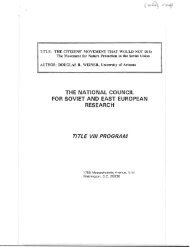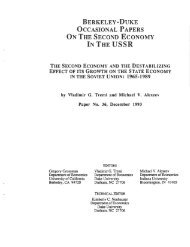The Russian Underground Economy in Transition - University ...
The Russian Underground Economy in Transition - University ...
The Russian Underground Economy in Transition - University ...
You also want an ePaper? Increase the reach of your titles
YUMPU automatically turns print PDFs into web optimized ePapers that Google loves.
personnel . <strong>The</strong> exist<strong>in</strong>g large literature on this phenomenon makes it po<strong>in</strong>tless to spend time o n<br />
it here . 7 A quote from Grossman (1977) presents a vivid general picture :<br />
At the very least one can deduce that the purchase and sale of [official] position s<br />
for large sums of money signifies the profound <strong>in</strong>stitutionalization <strong>in</strong> the Sovie t<br />
Union of a whole structure of bribery and graft, from the bottom to the top of th e<br />
pyramid of power; that considerable stability of the structure of power is expecte d<br />
by all concerned ; and that very probably there is a close organic connectio n<br />
between political-adm<strong>in</strong>istrative authority, on the one hand, and a highly develope d<br />
world of illegal economic activity, on the other . In sum, the concept o f<br />
kleptocracy, developed by sociologists with reference to corrupt regimes an d<br />
bureaucracies <strong>in</strong> underdeveloped countries, does not seem <strong>in</strong>applicable to at leas t<br />
certa<strong>in</strong> portions and regional segments of the Soviet party-government hierarch y<br />
(pp . 32-33) .<br />
For obvious reasons it is difficult to estimate the size of the Soviet illegal economy .<br />
Accord<strong>in</strong>g to estimates based on a Berkeley-Duke survey of emigrants from the USSR . about<br />
one third of the urban population's <strong>in</strong>come was derived from the second economy 8<br />
which<br />
employed 10 to 12% of the labor force . 9 Presumably, the bulk of this <strong>in</strong>come was illegal .<br />
Soviet researchers presented a variety of estimates of the illegal economy's turnover rang<strong>in</strong> g<br />
from 70-90 billion rubles to as high 300-350 billion rubles <strong>in</strong> the late 1980s . 1 0<br />
<strong>The</strong> dynamics of the underground economy is even more difficult to ascerta<strong>in</strong> . Koriag<strong>in</strong>a<br />
(1988) estimated that the second economy had grown approximately 4-fold between the lat e<br />
1960s and mid-1980s . Treml and Alexeev's (1994) research based on official retail trade an d<br />
<strong>in</strong>come data strongly suggested that the second economy was grow<strong>in</strong>g rapidly between 196 5<br />
and 1985, but they did not arrive at any specific growth estimates .<br />
While one may argue about the precise estimates of size and growth of the Soviet illega l<br />
economy, it is clear that by the mid-1980s it was hav<strong>in</strong>g a major impact on overall economi c<br />
performance. <strong>The</strong> illegal economic transactions to a large extent obviated ration<strong>in</strong>g i n<br />
consumer markets . For example, Alexeev (1988) demonstrated that even though residentia l<br />
7<strong>The</strong> standard references on Soviet corruption <strong>in</strong>clude Simis (1977-78, 1982) and Vaksberg (1992) .<br />
8Grossman (1987) . <strong>The</strong> estimates relate to the late 1970s . <strong>The</strong> Berkeley-Duke survey covered 106 1<br />
households from urban areas of the USSR . <strong>The</strong> survey sample conta<strong>in</strong>ed various biases such as self-selection o f<br />
the emigres, nationality (most of the respondents were either Jewish or Armenian), and others . <strong>The</strong>se biases ,<br />
however, did not appear to be large enough to <strong>in</strong>validate the reported estimates which are, <strong>in</strong>cidentally, quit e<br />
conservative .<br />
9Treml (1992) .<br />
10<strong>The</strong> first estimate is by Koriag<strong>in</strong>a (1988). <strong>The</strong> second number which was approximately equal to th e<br />
official retail trade turnover <strong>in</strong> the USSR is from Argumenty i fakty, no. 37, 1989, p . 5. <strong>The</strong> aggregate official<br />
personal <strong>in</strong>come <strong>in</strong> 1988-89 was roughly 522 billion rubles . Rutgaizer (1992) provides a survey of Soviet<br />
research on the second economy .<br />
4




